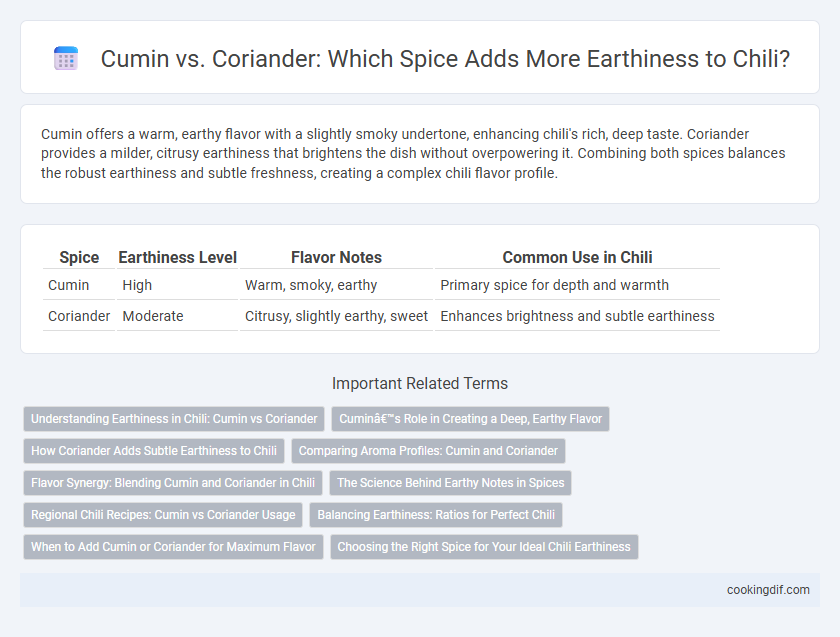Cumin offers a warm, earthy flavor with a slightly smoky undertone, enhancing chili's rich, deep taste. Coriander provides a milder, citrusy earthiness that brightens the dish without overpowering it. Combining both spices balances the robust earthiness and subtle freshness, creating a complex chili flavor profile.
Table of Comparison
| Spice | Earthiness Level | Flavor Notes | Common Use in Chili |
|---|---|---|---|
| Cumin | High | Warm, smoky, earthy | Primary spice for depth and warmth |
| Coriander | Moderate | Citrusy, slightly earthy, sweet | Enhances brightness and subtle earthiness |
Understanding Earthiness in Chili: Cumin vs Coriander
Cumin provides a deep, warm earthiness in chili with its nutty, smoky aroma that enhances the richness of the dish. Coriander, by contrast, offers a lighter, citrusy earthiness that brightens the flavor profile while maintaining subtle herbal undertones. Understanding the distinct earthy qualities of cumin and coriander allows for better flavor balancing and customization in chili recipes.
Cumin’s Role in Creating a Deep, Earthy Flavor
Cumin's role in chili centers on its ability to impart a rich, deep earthiness that enhances the dish's overall complexity. Unlike coriander, which offers bright, citrusy notes, cumin provides a warm, nutty base that grounds the chili with robust, smoky undertones. Its aromatic profile intensifies the savory character, making cumin a key spice for achieving authentic, hearty chili flavor.
How Coriander Adds Subtle Earthiness to Chili
Coriander seeds impart a subtle earthiness to chili by introducing citrusy and slightly sweet undertones that complement the dish's robust flavors without overpowering them. Unlike cumin, which provides a deep, smoky earthiness, coriander adds a lighter, more nuanced balance that enhances the chili's complexity. The combination of coriander's aroma and mild earthiness elevates the overall flavor profile, creating a more layered and vibrant chili experience.
Comparing Aroma Profiles: Cumin and Coriander
Cumin delivers a warm, earthy aroma with smoky and nutty undertones, enhancing chili dishes with deep, robust flavors. Coriander offers a lighter, citrusy, and slightly sweet fragrance that brightens the chili without overpowering its base notes. The contrast between cumin's rich earthiness and coriander's fresh, floral scent allows for a balanced and complex chili aroma profile.
Flavor Synergy: Blending Cumin and Coriander in Chili
Cumin and coriander create a complex earthiness in chili, with cumin delivering deep, smoky notes and coriander contributing bright, citrusy undertones that enhance overall flavor balance. Combining these spices unlocks a synergistic effect where cumin's warmth complements coriander's freshness, intensifying chili's aromatic profile. This blend elevates the dish by providing layered depth and a harmonious spice complexity that enhances both meat and vegetable ingredients in chili recipes.
The Science Behind Earthy Notes in Spices
Cumin contains the compound cuminaldehyde, responsible for its warm, nutty earthiness, while coriander features linalool and borneol, lending a citrusy yet earthy aroma. The volatile oils in cumin, primarily terpenes like terpinene, contribute to its deep, robust scent, contrasting with coriander's lighter, floral-earthy profile. Understanding these molecular differences highlights why cumin imparts a stronger earthiness in chili dishes, enhancing depth and complexity.
Regional Chili Recipes: Cumin vs Coriander Usage
In regional chili recipes, cumin delivers a deep, warm earthiness that dominates Southwest and Tex-Mex dishes, enhancing smoky and spicy profiles. Coriander offers a lighter, citrusy earthiness often found in Mexican and Central American chili variations, balancing heat with subtle citrus notes and floral undertones. Both spices enrich chili differently, with cumin anchoring robust flavors and coriander providing a bright, aromatic complexity.
Balancing Earthiness: Ratios for Perfect Chili
Balancing earthiness in chili involves using cumin and coriander in precise ratios, typically 2:1 cumin to coriander, to achieve a rich, aromatic depth. Cumin imparts a warm, smoky earthiness, while coriander adds a bright, citrusy undertone that enhances overall flavor complexity. Adjusting these ratios can transform a chili recipe, making the dish more robust or subtly fragrant depending on the desired taste profile.
When to Add Cumin or Coriander for Maximum Flavor
Adding cumin early in the cooking process allows its warm, earthy aroma to infuse the chili, enhancing the deep, smoky undertones. Coriander is best added towards the end of cooking to preserve its bright, citrusy notes that balance the dish's richness. Timing these spices correctly maximizes their distinct earthiness while creating a harmonious chili flavor profile.
Choosing the Right Spice for Your Ideal Chili Earthiness
Cumin delivers a warm, smoky earthiness essential for traditional chili, enhancing depth and intensity in the flavor profile. Coriander offers a lighter, citrusy earthiness that brightens the dish while maintaining complexity, making it ideal for a more nuanced chili experience. Selecting cumin emphasizes robust, hearty notes, whereas coriander introduces subtle, aromatic earth tones, allowing you to tailor the chili's earthiness to your preference.
Cumin vs Coriander for earthiness Infographic

 cookingdif.com
cookingdif.com